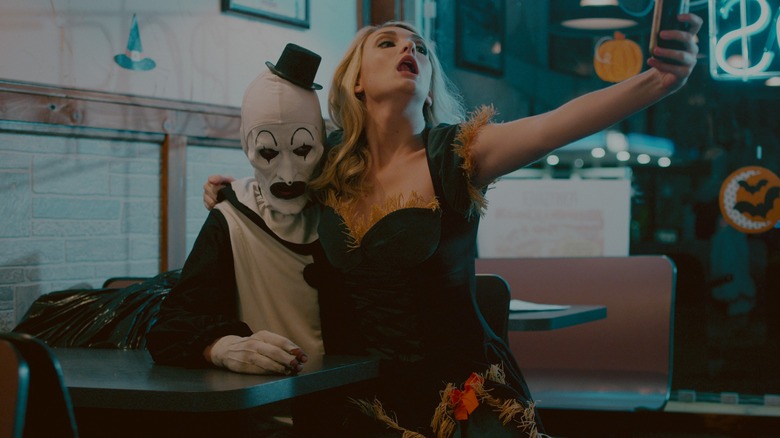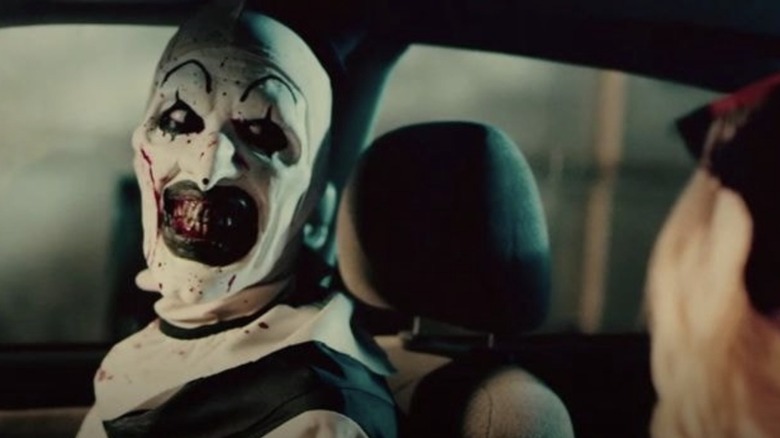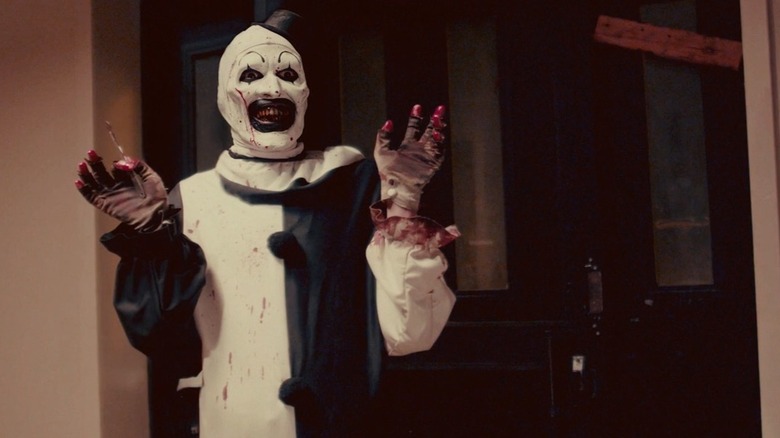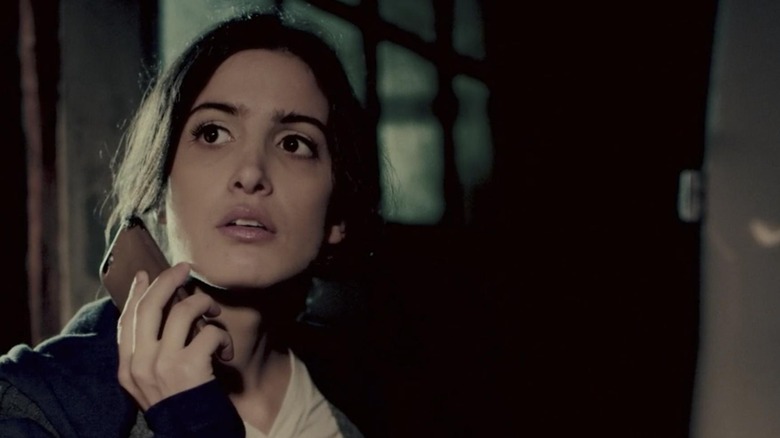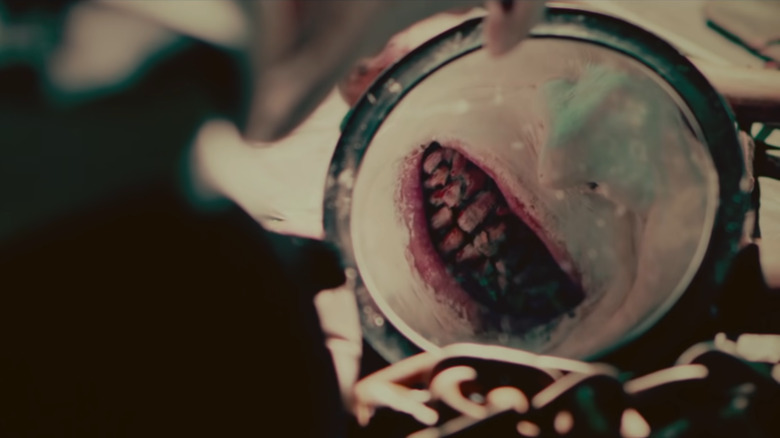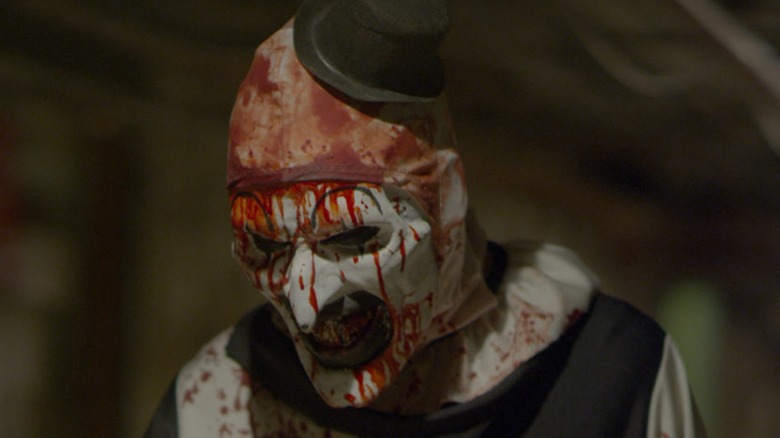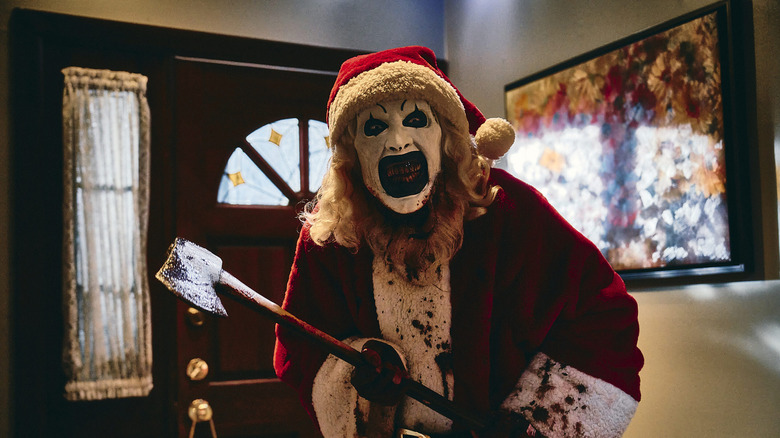Terrifier Ending Explained: The Bloody Birth Of A Franchise
We may receive a commission on purchases made from links.
"Terrifier" is the little slasher series that could. Writer-director Damien Leone harnessed decades of horror movie history to imbue his low-budget breakout with not just heaps of blood and uber-violence, but a subversive sense of whimsy as well. As a result, "Terrifier" remains one of this century's most successful indie horror titles. Its sequel, "Terrifier 2," carved out a success story all its own. In October 2022, that second installment pulled more than $10 million at the domestic box office. For reference, "Terrifier 2" is a two-and-a-half hour long gorefest. That's no chump change for what's arguably the bloodiest slasher movie of the decade. And when it hit theaters in October 2024, "Terrifier 3" also killed it at the box office.
It all goes back to the original, however, and without "Terrifier," there would be no franchise. Damien Leone first conceived of Art the Clown for the 2008 short "The 9th Circle." Art would later appear in the anthology horror movie "All Hallows' Eve." But "Terrifier" marked the beginning of Art the Clown's leading man status, this time portrayed by actor David Howard Thornton (taking over from the now-retired Mike Giannelli). It was a raucously gruesome ride, an indie darling that effectively metamorphosed into an entire franchise. Here, we'll be taking a look at what the "Terrifier" ending means and its connections to the now-mythic slasher series.
What you need to remember about the plot of Terrifier
The opening murder scene in "Terrifier" isn't committed by Art the Clown. Instead, the first movie opens with broadcast host Monica Brown (a brief yet vicious performance by Katie Maguire) interviewing a severely disfigured woman and the sole survivor of a killing spree that happened one year ago. Monica antagonizes the woman, speculating that Art the Clown might still be alive, though the woman is insistent he isn't — she saw him die. Later in her dressing room, Monica caustically disparages the woman and it proves to be her undoing. The woman appears, lunges at her, and gouges out her eyes.
From there, we meet friends Tara (Jenna Kanell) and Dawn (Catherine Corcoran), who have just wrapped their Halloween celebrations. In costume, they run into Art. Dawn thinks he's cute, though Tara reasons there's something off about this random clown. Horror convention dictates an arbitrary detour to a remote location, and after Dawn's car has a tire slashed, Tara absconds into an abandoned office building to use the restroom.
Art pursues, of course, and violently murders anyone in his way. But once you're convinced that it's following the '80s slasher playbook perfectly, "Terrifier" arrives at a subversive third-act twist.
What happened at the end of Terrifier?
For the brutal first half of "Terrifier," Tara makes for a pretty efficient final girl. She's quick to act, strategic, and pretty handy with a 2x4. Damien Leone, however, takes a different tack. As Tara looks to successfully take Art the Clown down, the killer comedically pulls out a gun and shoots her. It's a baffling moment, clearly played for laughs — slasher villains don't often use firearms, after all — though it leaves a protagonist-sized hole in the movie.
Luckily for the audience (though unluckily for her), Tara's sister Victoria (franchise mainstay Samantha Scaffidi) arrives. Tara had called her earlier, asking for a ride, and she arrives at the derelict building none the wiser. Foolishly, Victoria spends a protracted beat wandering through damp corridors and dimly-lit alleys, calling out for her sister. Victoria, why would Tara be in this random basement?
Inevitably, she runs afoul of Art, and the final reel is little more than a condensed iteration of the conventional slasher run-fight-hide ending. Art successfully mows Victoria down with a truck just as the police arrive, eating part of her face before he ostensibly dies by suicide. Art is taken to the morgue, reanimates, and kills the coroner. Victoria, it's revealed, is the disfigured woman from the opening scene. It's standard horror stuff (the villain always survives), but it yields profound consequences, especially given Victoria's place in the "Terrifier" lore.
Terrifier is just the beginning of Victoria and Art's story
Before "Terrifier 2" would expand on Art the Clown's mythology in surprising, terrifying ways, the first film managed, at its core, to simply be a grittily effective slasher movie. Defined by its gruesome set pieces (most notably a mid-movie nude bisection), "Terrifier" gamely carved a name for itself in a crowded horror space. Conceived with both love and craftsmanship (despite a $35,000 budget), "Terrifier" emerged as the rare indie horror release to successfully break into the mainstream.
Between the first and second movie, director Damien Leone inundated the franchise with plenty of lore. There are other dead clowns, familial connections, and rumors of Art being impossible to kill. That proves to be true, of course, as "Terrifier 2" protagonist Sienna (Lauren LaVera) kills Art several times, only for him to get back up again. Infamously, "Terrifier 2" ends with Victoria giving birth to Art's severed head, and Scaffidi returns with a bigger part to play as Victoria in "Terrifier 3," but the character is much, much different than the one we meet in the first "Terrifier."
What the ending of Terrifier means for the franchise
Not that it was unclear before, but the ending of "Terrifier" firmly establishes Art the Clown as an unkillable monster. Within the storied history of slasher films, that's not necessarily uncommon. John Carpenter's "Halloween" ends with Michael Myers surviving several gunshot wounds before disappearing into the streets of Haddonfield, and just about every "Friday the 13th" movie punctuates its ending with one final Jason Voorhees scare. "Terrifier," despite its modest origins, clearly had bigger, more mythic intentions, and in keeping both Art and Victoria alive, Leone cultivated what he needed for a shocking sequel.
Art the Clown was originally conceived as the broad idea of a clown terrorizing a woman on a bus. That nightmarish idea, of course, would springboard into the 21st century's most surprising popular horror franchise to date. No one could have anticipated the sunglasses-wearing goober of a clown would emerge as the slasher villain to beat, but he has. That trajectory is unequivocally linked to the first film's ending. In sticking to the rules of the slasher subgenre — never kill off your villain for good — Leone's confidence and adherence to history carved out the space to do something truly special.
The Terrifier saga only gets bloodier from here
In 2023, both "Terrifier" and "Terrifier 2" were re-released in theaters. That kind of fanfare is an undeniable sign that with just two movies, Leone has engendered a loyal fanbase of eager moviegoers itching to see what kind of brutality Art the Clown will get up to next. The ending of the first "Terrifier" might seem small-scale in its own right, but the sequel doubles down on the Art the Clown lore, filling the feature with plenty of biblical imagery and dense allegories to elevate it above its horror brethren.
Art the Clown is now firmly a supernatural killer to rival the likes of Michael Myers and Freddy Krueger. In essence, the ending of "Terrifier" has culled from the best of both worlds — Art is defined by Myers' unstoppable brutality and Krueger's tether to dream logic and surrealism. That clown represents big bucks, an uber-violent slasher killer whose final scare would pave the way for one of the most successful horror sequels of all time. Of course, if "Terrifier 3" is any indication, Art won't be slowing down any time soon.
What does the future look like for the Terrifier franchise?
In an interview with Bloody Disgusting, Damien Leone laid out his primary intentions for the wonderfully nasty and horrific "Terrifier 3." "My goal going into this, first and foremost," the filmmaker said, "was to go back tonally more in the vein of 'Terrifier,' in terms of just the simplistic, grindhouse, gritty, dirty slasher that I love and what made it what it is." Leone similarly suggested that it would be a mistake to depart too much from what made the first work. For reference, "Terrifier" is exactly what Leone describes — a truncated, merciless slasher film. "Terrifier 2" is much bigger and more mythic, expanding the universe in potentially unsustainable (albeit exciting) ways. And "Terrifier 3" only increases the ever-growing mythology of the franchise, proving Art is more than just a mindless killer butchering folks for no reason.
"Terrifer 2" felt like something altogether new, whereas the first "Terrifier" made waves within an established space. "Terrifier 3" ties things together (and pays off the linger questions about Art and Victoria's relationship from the first movie), but leaves room for "Terrifier 4," which Leone has indicated could be the final Art the Clown movie, or perhaps the second-to-last. The scope of the "Terrifier" franchise seems to be getting bigger with each subsequent entry, but you have to imagine there's an eventual endpoint for this franchise. How much longer can Art the Clown keep getting away with this? At the very least, Leone says he has a vision for how things wrap up. ""I can't see it going further than one or two more films, but only time will tell," he said, adding: "For now, all I can say with certainty is that I know how it ends, and it will be epic."
